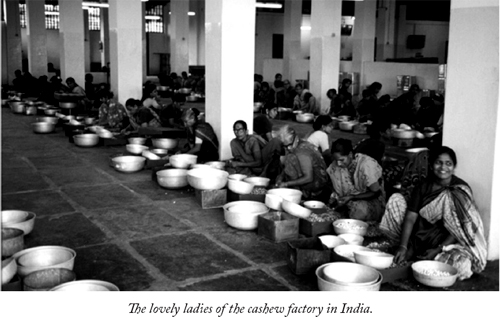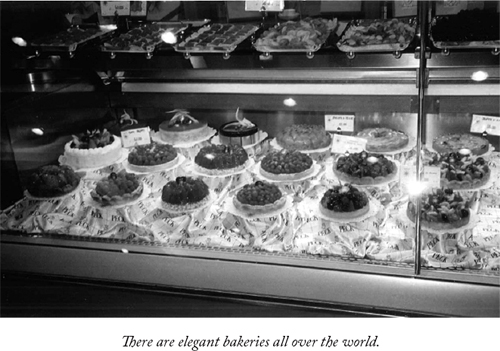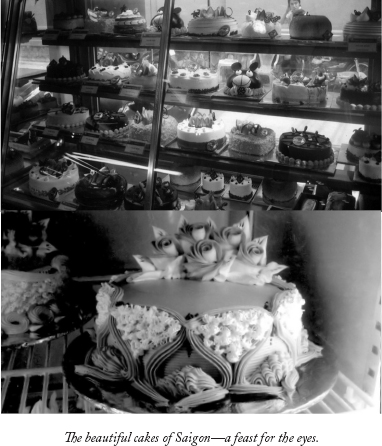With Love and Quiches (32 page)
Read With Love and Quiches Online
Authors: Susan Axelrod

Once we got under way on the Yangtze River “cruise ship”—and I use the term loosely, since we noticed more than once that they washed the dishes off the back of the boat in the not-too-clean river water—we were rewarded with truly majestic and mountainous scenery as we stopped in small towns and cities along the way until we finally reached Shanghai.
This
city had color and then some. We spent one of the days walking for hours and hours and found our way to the Bund, an area along the river embankment in the center of the city. There are lots of older buildings here, and building height restrictions are enforced to keep the flavor of the area. In the American Hotel, which was not American but, instead, a small, elegant, and old-fashioned place, we had a lovely lunch overlooking the water and all the activity below.
Beijing, in contrast, was much more gray and formidable, but we had the best Peking duck that we have ever tasted: tender meat, crisp squares of skin from which
all
the fat had been rendered, and all the accompaniments. We insisted they bring us the carcasses—much to the waiter’s surprise, since I’m sure they had planned to use it for the next day’s stock—and we gnawed on them until the table was
completely
strewn with the bones!
I remember China more for its noodles than its rice, and for many of the meals the noodles were stretched and cut for us right before our eyes—long, thin, chewy, and sensuous. Unforgettable.
Wherever we traveled, we always sought out the wholesale markets, wholesale bakeries, and such—in other words, those businesses, both large and small, that serviced the same type of establishments that we did at home in the United States: restaurants, hotels, caterers, retail shops, cafés, and all the rest. We’ve found that any place, anywhere, there are
always
bakeries.
In Central America we happened upon a local bakery supplier on the top of Monte Verde in Costa Rica whose owner claimed to have been baking there forever. It had the same kind of Hobart mixers that we did and the same kind of racks, pans, and rotary ovens, however ancient, that we did.
In South America we stopped in Ushuaia, in Argentina, which is regarded as the southernmost city in the world. There we found and were given a tour by the very friendly proprietor of a wholesale bakery located on all five floors of a perilously narrow building. There were just very steep staircases, up and down which hundred-pound bags of flour and all the other ingredients were constantly being transported. We were enveloped in the clouds of flour and sugar dust that permeated the whole building. This bakery serviced almost every food establishment in the whole city, and it was a beehive of efficient activity. They were turning out a lot of goods, all of them top quality.
But by far the most fascinating and jaw-dropping tour we have ever had was of a cashew processing plant in New Mangalore, near that port in India. It all happened quite serendipitously. We just happened to mention to our guide that we were in the food manufacturing business, and our guide said she belonged to a Symphony Society whose director, a Mr. D’Souza, owned one of the largest cashew processing plants in the world; she insisted we stop by to meet him if he was in his office. He was.
He welcomed us very graciously, and we first spent an hour comparing notes about our businesses. He described the cashew industry around the world for us, with India having the lion’s share. Then he offered us a drink before our tour of the plant. (To digress: while in India, it is very important to drink
nothing
unless it comes in an unopened bottle. You risk getting
very
sick.) We politely said we weren’t thirsty. He nodded and then called in his general manager, and our tour began.
The facility was very large, and we were first brought into a vast room, as large as a football field, with several hundred women all lined up in rows, sitting on the floor with piles of shells on one side of them and the pile of nutmeats on the other side.
On the floor!
This was quint-essential handwork, and their hands moved so quickly that one could hardly follow the movements. Then the nutmeats were transported in wheelbarrows to the oven rooms and transferred onto trays for roasting. The ovens were so thickly blackened and so ancient that they took my breath away. When the manager pulled out a tray (the same ubiquitous and universal bun trays) to show us the roasting process, some of the nuts got away and fell to the floor; he blithely gathered them up and put them back on the trays. Then he smiled and simply popped them back into the oven.
By now I was thinking that I would never eat another cashew nut as long as I lived, but as we moved through the rooms and the processes, the areas became cleaner and cleaner, as did the equipment, until we finally found ourselves surrounded by glisteningly clean walls and stainless steel tables and equipment for the final sorting, quality checks, and packaging. During the processing steps, nothing goes to waste. The shells are burned for fuel, the skins are used to produce color dyes, and subquality nuts are sold somewhere to someone. It was fascinating. The tour took more than two hours.
We were escorted back to Mr. D’Souza’s office. “So
now
you must be thirsty?” he inquired. After such hospitality, we would never dream of insulting our host. “Yes, we are,” I answered, fully prepared to die if necessary. But on the tray shortly brought in were only bottles of lemon soda pop and a bottle opener. I had underestimated our elegant host! The soda was tooth-shatteringly sweet, but we drank every drop! As it happened, he also owned the soda bottling plant as well as other businesses in the region: cars, electronics, and others. These are the kind of experiences that aren’t easily forgotten.

On that same trip, which was on a small cruise ship with only a hundred passengers, we had started out in Singapore and continued on to Malaysia, with stops in Penang and Kuala Lumpur, then to Phuket in Thailand, then on to India, with stops in Cochin—a fishing port with the most unusual boats whose nets resembled vast yet exquisitely delicate spider webs—New Mangalore, home of the cashews, Goa, a Christian enclave and a market town, and finally Bombay, now called Mumbai. We ate our way through these places, albeit carefully, and we came away with a thirst for more exotic travel
and
a great passion for mangoes!
Of all the countries we have visited, India, with all its beauty, smells, colors, contrasts, and both poverty and riches, remains my favorite. In spite of the poverty, there is a sense of both peacefulness and vibrancy among the populace that’s like no other place in the world.
Our next trip to India, in 2006, began in Mumbai, and we traveled through inland Rajasthan, visited the Taj Mahal, and ended in Delhi.
The chaotic food markets and bazaars in Mumbai are a feast for the eyes, especially the Crawford Market, built in 1869, a vast marketplace with a startling array of fruit, vegetables, meats, poultry, spices, cheeses, chocolates, and on and on. Runners, mostly barefoot, carry and deliver purchases packed in huge baskets balanced on their heads.
On this trip there were six of us: a couple from Maryland, with whom we have formed a friends-for-life relationship, and never-to-be-forgotten Mary, almost ninety, who was traveling with her niece. This was a strenuous trip, and Mary admitted: “I very simply lied through my teeth when I filled out the form that I was fit for any eventuality. I very much wanted to see the Taj Mahal before I died.” We left Mary behind quite often, which she was happy with as long as she had her martinis to keep her company with each meal, even breakfast.
Rajasthan was a sensual whirl of colors, odors, lushness, and emotions. It was simply gorgeous, with stunning scenery, and because we wanted to see it all, we drove through the countryside from city to city rather than flying as originally planned. As usual, we ate our way through the region. We were a bad influence on our traveling companions, but the food was terrific. I became a tikka masala aficionado, but didn’t try any street food, a hard and fast rule with me in certain countries.
We visited Jodhpur, the Blue City, because of the color the Brahmins use to paint their houses; Jaipur, the Pink City, painted pink for Prince Albert when he visited India in the late 1800s; Udaipur, the city of lakes, the Venice of India; and many small villages and farms along the way, which were almost the best of all. There are food stalls, camel carts, cows, elephants, and monkeys all over the place, even in the cities. We walked along sidewalk shops that overflowed with luscious foodstuffs, pottery, and fabrics.
Rajasthan is going green, and at one “organic” farm we visited along the way, one of the main crops very closely resembled opium. They cooked it up and invited us to all partake of a spoonful. I couldn’t get myself to do it, but everybody else did!
On this trip, we stayed at almost embarrassingly decadent and opulent hotels, perhaps more beautiful than anywhere else in the world. Most of them are housed in actual converted palaces, no replicas here, and with service to match.
In Agra, the Oberoi Amarvilas resort was the best of all, and our visit to the Taj Mahal just before dawn was haunting. It was a
very
long walk. Mary stepped up to the plate and made that walk with us; this was, after all, why she came. Delhi was much like Mumbai. It was much more buttoned up, but had the same great food. (Our farewell dinner on this trip was, by the way, Chinese food: Cantonese, Peking duck, and all the other usual suspects.)
Our next trip, in 2009, began in Singapore, where we were to meet a customer and a personal friend. Singapore is pristine and new; all the old neighborhoods have been razed and replaced with new neighborhoods
made
to look old. It is an independent city-state that was part of the British Empire until a little over fifty years ago, and you can see the British influence in the architecture and at world-famous Raffles Hotel.
We spent one of the days touring all the food markets and bakeries with our friend. The supermarkets are all quite modern and there seems to be a bakery on every street with very elegant and elaborate cakes and pastries of the type found in major cities the world over. They love chocolate! Singapore is a great target for Love and Quiches.

Our next stop was colorful Bangkok. Our dinner that evening holds a place way up there. I admit that elegant dining in a beautiful setting is among my favorite pastimes. We booked a table at Le Normandie, considered by many to be the finest French restaurant in Asia, on the top floor of the exquisite old-world Oriental Hotel. We were seated at the window and enjoyed wonderful views of the river and promenade below with our perfect and quite memorable dinner, and with a price tag to match!
Vietnam was the main focus of this trip, and Ho Chi Minh City (Saigon) was our best stop. Saigon is a bustling port city with a fragrant profusion of fruit, flowers, and foodstuffs everywhere we turned. There were open markets where meats and fish were also spilling into the streets with no particular emphasis on refrigeration, but where everything looked fresh and appetizing. There were also many bakeries with displays of quite elaborately constructed cakes, similar to the displays we had found in other larger Asian cities. The bread here looked particularly good, possibly because Vietnam was originally part of French Indochina. Wherever we have traveled throughout Asia, our overall impression is of an overabundance of food.

